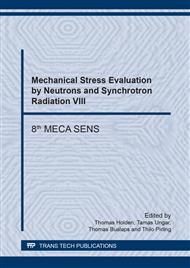p.3
p.9
p.17
p.25
p.31
p.40
p.46
p.52
Characterization of Microscopic Stresses in a Polycrystalline Fe-Ga Alloy with Large Elastic Anisotropy
Abstract:
Fe-Ga alloys show large magnetostriction, which strongly depends on crystal orientation. This phenomenon is associated to some degree with large elastic anisotropy. In this study, white X-ray diffraction with micro-beam synchrotron radiation was used to evaluate the microscopic stresses evolved in a polycrystalline Fe-Ga alloy under tensile loading. In the analysis, the large elastic anisotropy of the Fe-Ga alloy was focused. The stress distribution in the alloy microstructure under tensile loading was estimated using a finite element method (FEM) simulation that considered the dependence of the elasticity on the crystal orientation. The crystal orientation of grains in the polycrystalline Fe-Ga alloy was measured using electron backscatter diffraction. The FEM simulation showed that the stress distribution in the microstructure depended on the crystal orientation. The X-ray diffraction stress analysis indicated that under tensile loading, the stresses in the alloy depended on the crystal orientation. This finding is similar to the results obtained from the FEM simulation, although the absolute values of the stresses may have reflected the effects of heterogeneous deformation on the stress distribution.
Info:
Periodical:
Pages:
3-8
Citation:
Online since:
August 2017
Price:
Сopyright:
© 2017 Trans Tech Publications Ltd. All Rights Reserved
Share:
Citation:


